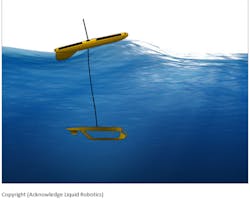Boeing's agreement to acquire Liquid Robotics will build upon its capabilities in autonomous maritime robots and aerospace systems. Liquid Robotics is a small private company responsible for creating the Wave Glider—an ocean-surface robot that collects data while being propelled by ocean currents. Solar panels power sensors onboard, and operations can be controlled remotely or through an autonomous controls center. In 2014, the two companies worked together on a Sensor Hosting Autonomous Remote Craft (SHARC)–the defense version of the Wave Glider. It employs Boeing sensors to track satellites, manned and unmanned aircraft, and sub-surface crafts.
Tthe Wave Glider is deployed in oceans worldwide to serve markets including defense and national security, meteorology, oil and gas, commercial security, and scientific research. There have been 16 cases where they have traveled through hurricanes, cyclones, and typhoons while continuing to transmit real-time weather data from the surface of the ocean. They consist of a boat that floats on the surface and a tethered sub-sea device that gathers energy via airfoils from underwater turbulence. They offer a service life that typically ranges from 6 to 9 months, and can be equipped with a variety of sensors, including ADCP current profilers, weather stations, fluorometers, hydrophones, cameras, and water-quality sensors. Watch the video below for an illustration of how it works:
Liquid Robotics will become a subsidiary of Boeing, and will operate under its current business model. It will report to Kory Mathews, vice president of Autonomous Systems for Boeing Defense, Space & Security. “I am proud of our team, culture, and relentless commitment to designing the best ocean surface robot in the maritime industry,” said Gary Gysin, president and CEO of Liquid Robotics. “This acquisition allows us to leverage the strengths of one of the world’s leading global companies while continuing to push our innovation to new levels.”
About the Author
Leah Scully
Associate Content Producer
Leah Scully is a graduate of The College of New Jersey. She has a BS degree in Biomedical Engineering with a mechanical specialization. Leah is responsible for Machine Design’s news items that cover industry trends, research, and applied science and engineering, along with product galleries. Visit her on Facebook, or view her profile on LinkedIn.

